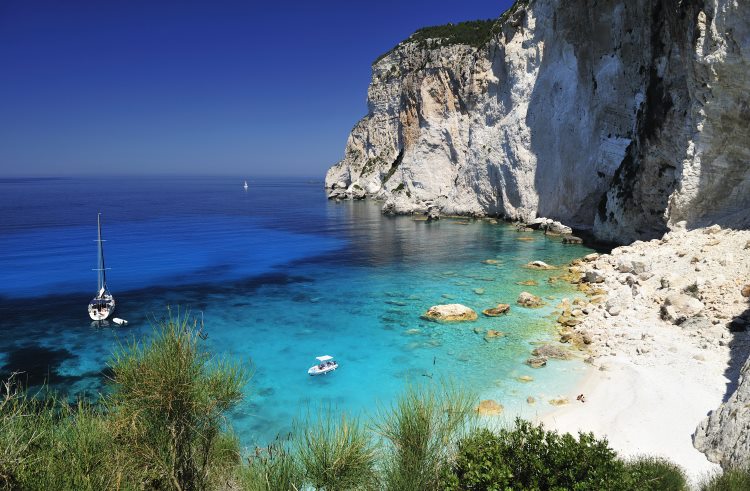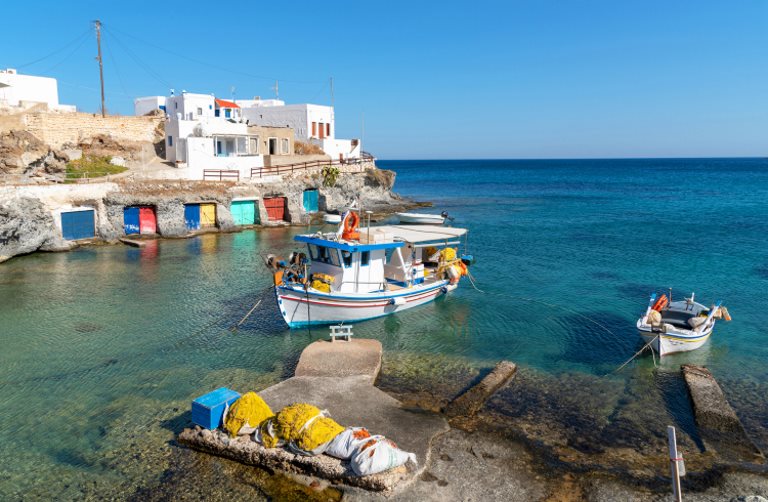Which Greek islands or island chains should you visit? What's the best way to get around? How should you plan your island-hopping itinerary for maximum efficiency and minimal crowds? Local Rebecca shares her tips.
 Photo © Getty Images / Edward Staines
Photo © Getty Images / Edward Staines
Greece has more than 6,000 islands divided into six main chains, as well as the stand-alone islands of Crete and Evia.
You’ve probably heard of the popular islands of Santorini and Mykonos, both in the Cyclades chain and distinguishable for their sugar cube-shaped houses and blue-domed churches.
But my favorites are lesser-known, and being based in Athens, I love traveling to them by ferry.
- Is it easy to island hop in Greece?
- Is island hopping in Greece expensive?
- The six main island chains in Greece
- Island hopping the Ionian Islands
- Exploring the Dodecanese Islands
Is it easy to island hop in Greece?
One great thing about the Greek islands – even the smaller ones are typically accessible by ferry. The bigger ones, such as Santorini, Mykonos, Rhodes, and Zakynthos, have airports with direct flights from many European destinations in high season, or Athens year-round. Depending on the size of your budget, you could fly between islands.
But if you’re island-hopping by ferry, I suggest keeping within the same chain because the country’s geography is so vast. It’s not practical to island hop by ferry between Santorini-Rhodes-Corfu as they’re located in completely different parts of Greece. Even within the island chains, allow yourself enough time to connect, as ferry services don’t always run daily. Grab a map of Greece, make a plan, and spend a week to 10 days to really get a good feel for a few islands in one chain.
Is island hopping in Greece expensive?
This depends on whether you choose to fly or take the ferry. Flying can save time, but with virtually zero airline competition, fares tend to be expensive, starting from US $72 (€66) one-way, for example, from Athens to Rhodes, low season.
Despite the fact there are over 20 different ferries, including hydrofoil services, in Greece, all serving similar or different routes, none offer a package of discounted tickets, choosing instead to run random offers such as a 20% discount to members, but only after accumulating a certain number of miles.
I’d recommend budgeting approx. US $30-36 (€25-€30) per person per ferry ride and being smart in your travel planning: choose to hop between islands within the same chain and also on the same route, cut down on the number of islands you visit, choose a slow ferry with outside seating as opposed to a faster, more expensive ferry with an indoor seat.

Many routes from the Athenian ports of Piraeus and Rafina offer a range of fares from US $36-42 (€30-€35), increasing to US $97-121 (€80-€100) if you choose an airline-style, indoor seat or cabin. Which you choose depends on your expected comfort level and how long the journey is. Slow ferry journeys to some islands can take up to 10 hours, with many stops along the way.
Personally, I think the journey is part of the fun, and love being at sea – I look forward to a ferry ride whenever I can. There’s always a public lounge to sit in with food and snacks to buy.
The six main island chains in Greece
Your travel planning for the Greek islands is made easier due to the distinctive island chains, each with their own charms.
The Cyclades – famous for their white and blue houses, windmills, and sandy and volcanic beaches – contain around 220 islands, only 33 of which are inhabited. The most famous of the main islands are Santorini and Mykonos. For a quieter experience, consider Kimolos or Irakleia. This island group is approximately 93mi (150km) from Athens.

The Saronic and Argosaronic islands are lesser known to international travelers, yet shouldn’t be overlooked. As they’re the nearest from Athens – an hour’s ferry ride to the beautiful, pine-forest island of Aegina – many Athenians have summer homes here and visit on weekends.
The Sporades are in the Aegean Sea on the east coast, with four main islands and several uninhabited ones. Skiathos is the busiest – its neighbor Skopelos is known for its greenery, whereas Alonissos has Greece’s first underwater museum and is famous for its monk seal population. Travel here either by ferry from Agios Konstantinos or Volos, or fly to Skiathos.
The Northeast Aegean Islands, in the northern Aegean Sea, are the nearest to Turkey. The biggest ones are Lesvos and Samos, both with airports and famed for being mountainous and rugged.
Dodeca in Greek means “12”, hence the Dodecanese chain has 12 main islands. Kos and Rhodes are the most popular, both with international airports. Some of the smaller islands have regional airports, and are all accessible by ferry from Piraeus port in Athens. Rhodes is renowned for its UNESCO-listed Old Town, the oldest continually inhabited medieval town in Europe.
The Ionian islands on the west side of the mainland, reaching as far up as Albania, are nicknamed the “Caribbean of Europe” due to their azure waters and white sand. Corfu, Zakynthos, and Kefalonia – where Captain Corelli’s Mandolin was filmed – are the most famous, but other, smaller ones are also worthy of exploration too.
I’ve done most of my exploring in the Ionian and Dodecanese islands – read on for my tips on the best ways to enjoy them.
Island hopping the Ionian Islands
The Ionians are one of my favorite island chains, with their turquoise waters, limestone cliffs tumbling down into the sea, and lush, green vegetation due to winter rains. Their beauty makes my preferred activities – relaxing on a white, sandy beach, drinking frappe in a small fishing village café, or trekking in the forests – especially worthwhile.
Corfu has a wonderful castle and old town, yet it’s the much smaller, less touristy islands of Paxos, AntiPaxos, Ithaca, and Lefkada that are the pull for me. I love evening drinks in village squares with the locals, and spending days lazing on quiet beaches and seeking out hidden churches along hiking paths, getting in touch with the real Greece.

Exploring the Dodecanese Islands
Located in the Aegean Sea off the coast of Turkey, this cluster of islands has gorgeous, warm temperatures most of the year – there’s no bad time to visit.
I love wandering the cobbled streets and castle walls of the UNESCO Old Town of Rhodes, as well as historic Kos, also famous as the birthplace of medicine – Hippocrates was born here. But they do attract package-tour crowds, so I hop onto a ferry from Rhodes to the quieter island of Symi, with its colorful Venetian houses clustered on the hills rising from the sea and its small, pebbly coves.
Despite exploring the Dodecanese every couple of years, I always feel there’s something new to discover.
The Greek islands have something for everyone – just put quality over quantity and take your time.
Related articles
Simple and flexible travel insurance
You can buy at home or while traveling, and claim online from anywhere in the world. With 150+ adventure activities covered and 24/7 emergency assistance.
Get a quote


No Comments